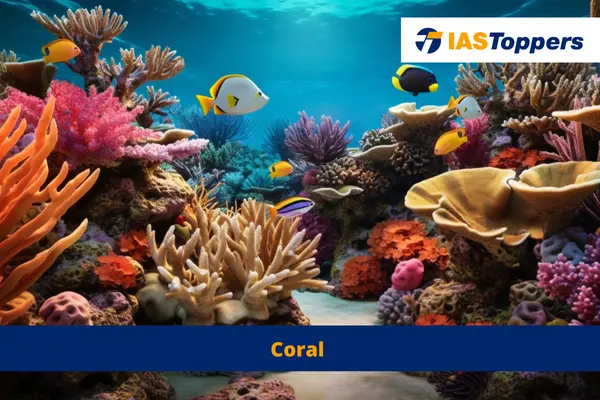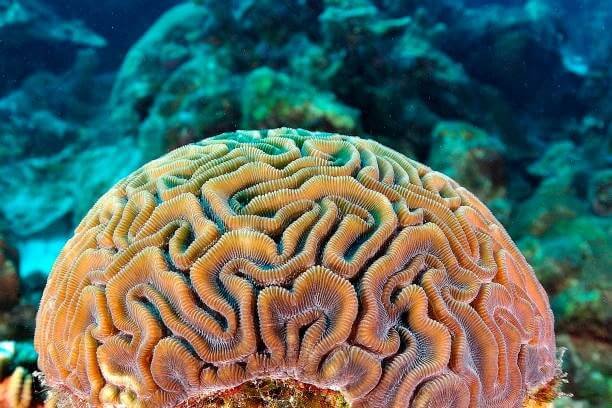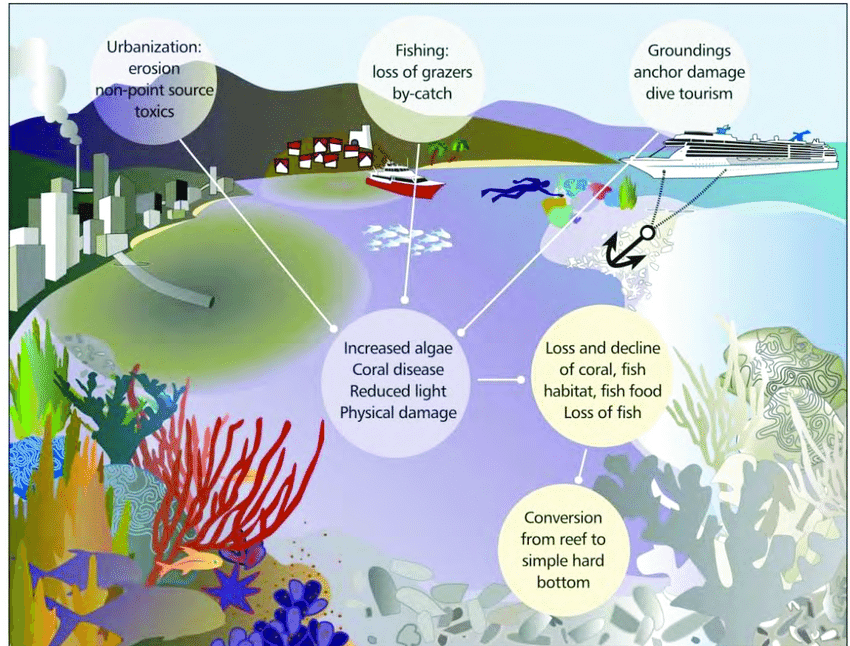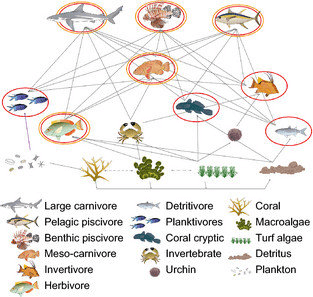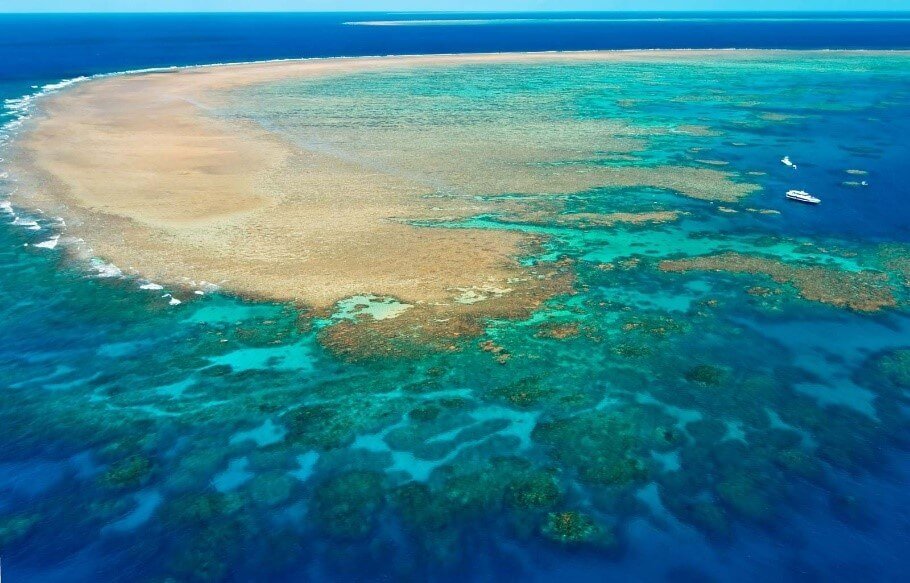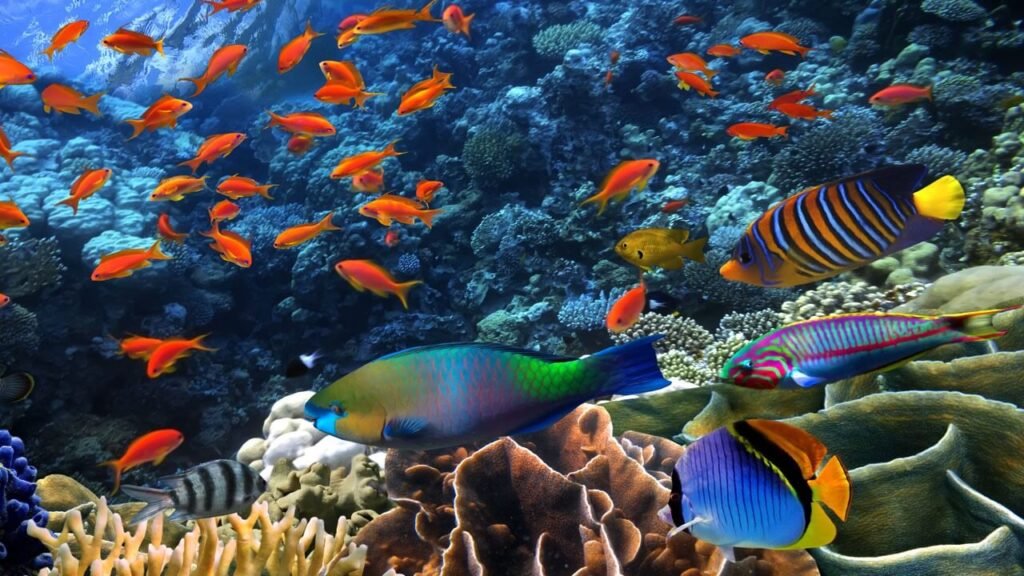Coral are small immobile animals of the phylum Cnidaria that live in the ocean and do not have a well-developed backbone. In this article, you will learn about corals and coral reefs, coral reef ecosystem characteristics, coral island in India, providing key insights for GS Paper-III of section Environment and Ecology of UPSC IAS Exam.
Table of Content
- What are Coral polyps?
- What is Coral reef?
- Coral reef ecosystem diagram
- The Coral reef ecosystem food web
- What is Coral Island?
- Ideal environment for Coral ecosystem
- What is Coral Bleaching?
- Causes of Coral Bleaching
- Importance of coral ecosystem reefs
- Government initiatives to protect Coral reefs
- Conclusion
- Frequently Asked Questions
What are Coral Polyps?
- Coral polyps are small immobile animals that live in the ocean and do not have a backbone.
- Polyps belongs to the Coelenterata class and the phylum Cnidaria.
- When coral polyps die, their hard lime skeletons stay on the rocks, and new corals grows on them.
- Coral polyps have different shapes, forms, and colours.
- The warm, clear, salty waters is an ideal environment for both coral polyps and fish.
Brain coral: is a common name given to various corals of the family Mussidae and Merulinidae due to resemblance to brain.
What is Coral Reef?
- A coral reef refers to a raised portion of the seafloor that approaches the surface, typically found in shallow areas.
- Examples: coral island Pattaya in Thailand, coral sea of Australia etc.
- The deep sea coral reefs ecosystem is also known as mounds and is a left behind dead coral.
- The coral reef formation takes place when coral polyps forms colonies and are held together by the calcium carbonate.
- The characteristics of coral reef ecosystem includes reef-building corals in a symbiotic relationship, rich biodiversity of organisms among others.
- The mesophotic coral ecosystems are found in tropical and subtropical regions at depths of almost 100 feet to over 490 feet below the ocean’s surface.
- Types of coral reef: Fringing reefs, barrier reefs, and atolls.
- Fringing reefs form along the shoreline of an island and are extend outward.
- Barrier reefs develops away from the shore and creates a channel or lagoon.
- Atolls are islands composed of coral.
- Coral reefs in India can be found in: Gulf of Mannar, Palk-bay, Lakshadweep coral reef (atolls), Gulf of Kutch, and Andaman and Nicobar.
- The health of coral reefs is affected due to factors such as water pollution, destructive fishing practices, algal blooms, eutrophication, coral diseases, and coral bleaching.
- Coral reef ecosystem abiotic factors: water, temperature, sunlight, salt, and waves etc.
Types of coral reef:
Coral reef ecosystem diagram:
The Coral reef ecosystem food web:
What is Coral Island?
- The coral island is a type of island that is formed from coral detritus and other organic materials.
- The coral island occurs in tropical and sub-tropical areas as an extended part of a coral reef.
- Great Barrier Reef is the largest coral reef in the world situated in Australia.
- The coral island Lakshadweep have coral origin.
Great Barrier Reef coral:
Ideal environment for Coral ecosystem:
- Consistent Climatic Conditions: Corals require stable climatic conditions for long periods of time, as they are highly sensitive to rapid changes.
- Clear Saline Water: Optimal coral growth occurs in clear salt water, while both freshwater and highly saline water are detrimental to its health.
- Warm Tropical Waters: Corals grows better in tropical waters within the latitudes of 30°N and 30°S, where the water temperature is approx. 20°C and has minimal fluctuations.
- Minimal Pollution Impact: Corals are highly susceptible to climate change and pollution. Even a slight increase in marine pollution can have bad effects on coral health.
- Plentiful Plankton: Adequate oxygen and microscopicmarine food- plankton (specifically phytoplankton) is vital for its growth.
- Corals flourish rapidly on the seaward side where plankton is abundantly found.
What is Coral Bleaching?
- It is the phenomenon in which coral colonies turns white due to the loss of symbioticrelationship with the zooxanthellae from the polyps’ tissues.
- Zooxanthellae is a single-celled algae that provides color and food to corals.
- When the symbiotic relationship breaks down, the polyp starves and dies.
- This exposes the white calcium carbonate skeletons of the coral colony.
- Deep sea corals live in deeper ocean and thus lacks zooxanthellae.
- The coral reef bleaching can lead to loss of habitat for many fishes, impacts tourism sector and indigenous people who depends on it.
Causes of Coral Bleaching:
- Stresses and environmental changes can trigger bleaching, excessive shade, sedimentation, pollution, salinity changes, and increased temperatures.
- Increased exposure to ultraviolet (UV) radiation.
- Heavy rainfall causing flooding of the reef.
- Exposure to certain chemicals or diseases.
- Excessivenutrients such as ammonia and nitrate from fertilizers and household products entering the coral reef ecosystem.
- Nutrients may increase the number of zooxanthellae but they can make corals susceptible to diseases.
- Extreme warm water especially experienced during El Nino years can affect the health of the Coral.
- Coral reef gets exposed during tsunami because of being at junction of ocean and land., leading to their bleaching.
- Coral reef protects the strong impact of Tsunami or cyclones from hitting the hinterland by acting as a buffer against such calamities.
Importance of coral ecosystem reefs:
- Biodiversity Support: Coral reefs provides residence to diverse fish populations, animals and seabirds.
- The coral reef animals include- Whale Sharks, Sea Turtles, Dugongs, Ospreys etc.
- Carbon Dioxide Regulation: it regulates carbon dioxide levels in both the atmosphere and the sea water.
- Raw Material Source: it provides raw materials for various industries.
- Wave Control: it protects coastal areas by reducing the speed of incoming sea waves.
- Greenhouse Effect Mitigation: Coral reefs aid in mitigating the Greenhouse Effect by absorbing carbon dioxide.
- Medicinal Use: Coastal communities utilize corals as medicinal resources.
- Ecosystem Importance: it supports a wide range of marine life, including animals like starfish, while also providing a source of food.
- Economic importance: promotes tourism and provides rich fishing ground as coral houses many Coral reef fish.
Coral reef fish:
Government initiatives to protect Coral reefs:
- Coastal Regulation Zone (CRZ) have been implemented to regulate developmental activities along the coastal areas and protect coral reefs.
- The Indian Forest Conservation Act of 1980 plays a significant role to conserve coral reefs.
- The Integrated Coastal and Marine Area Management aimed to integrate the management of coastal and marine areas.
- It resulted in the development of model plans for the Gulf of Kutch.
- The National Coastal Zone Management Authority (NCZMA) and State Coastal Zone Management Authority (SCZMA) protects the coastal and marine areas.
- The National Committee on mangroves, wetlands and coral reefs advises the Government on policies and programmes regarding marine species.
- The Biological Diversity Act of India,2002 and the Biological Diversity Rules 2004 advises the Government on protection of biodiversity, sustainable use, Intellectual Property Rights, etc.
Conclusion
Coral ecosystems play a vital role in marine biodiversity as it provides a habitat for a wide range of marine species. The conservation of coral reefs are essential for maintaining the balance of coastal ecosystems. Human activities, such as pollution and overfishing, poses significant threats to these delicate ecosystems.
Ref:
FAQs(Frequently Asked Question)
What is the meaning of coral?
Coral are small immobile animals of the phylum Cnidaria that live in the ocean and do not have a well-developed backbone.
What is a coral reef ecosystem?
A coral reef ecosystem refers to a raised portion of the sea floor that approaches the surface, typically found in shallow areas.
Why is Lakshadweep known as a coral island?
Lakshadweep is a group of islands having Coral origin, thus, it is also known as the coral islands.
What is the economic importance of coral reefs ecosystem?
Coral Reefs promotes tourism and provides rich fishing ground.
How are coral reefs formed?
The coral reef formation takes place when coral polyps forms colonies and are held together by the calcium carbonate.
What biotic components are present in coral reef ecosystem?
The coral reef ecosystemorganismsincludes plants, crabs, fish such as Whale Sharks, Sea Turtles, Dugongs etc.
What are some of the coral bleaching effects on ecosystem?
The coral bleaching effects the entire reef ecosystem as once coral starts dying, the rest of the remaining corals finds it difficult to reproduce, vanishing the entire landscape.
Why are coral reefs the most productive ecosystems?
The coralreefs are the most productive ecosystems due to efficient biological recycling and a high retention of nutrients.
What does coral do for the ecosystem?
The coral reefs provide habitat for a large variety of marine life and acts as a buffer against many natural calamities such as Tsunami and cyclone.
Why are coral reefs fragile ecosystems?
: The coral reefs are prone to temperature, salinity, alkalinity of water etc for their survival. Once these ideal conditions are deteriorated the coral bleaching starts happening.


